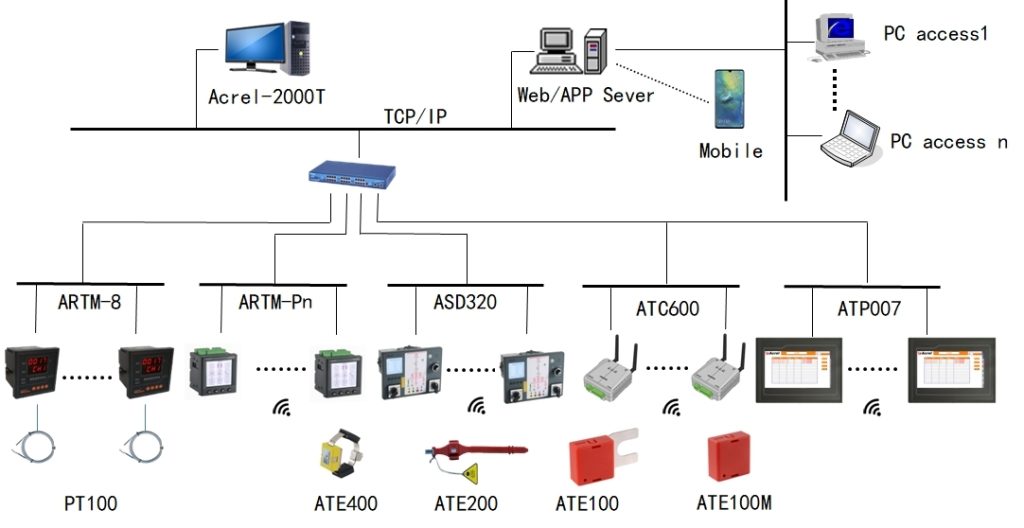
Intelligent buildings are modern achievements that combine cultural landscapes with ecological nature. Aiming to provide people with a safe, reliable, comfortable and natural living environment and an active and healthy lifestyle.
It integrates the data communication, voice communication and multimedia communication of the whole building or the whole community to form a communication network with a wide range and rich content. Such a modern communication method effectively meets the efficient and fast-paced work needs of modern information society. An electronic monitoring system provides an intelligent system platform for unified monitoring and management of high and low voltage power distribution, information exchange, and resource sharing in the building.
The power monitoring system uses modern network technology and computer video technology to monitor the operating parameters, event records, wave records and other data of the power system.
At the same time, it is continuously transmitted to the power monitoring computer and implemented remote control commands, so that operation managers can fully understand the operating status of the power system through the monitoring center. Therefore, the location and cause of the fault can be accurately and quickly judged, the work process is simplified, and the staff can provide a limited way to solve the problem in a targeted manner.
Power monitoring systems are widely used in smart buildings. Solar energy, solar greenhouse, water ring heat pump air conditioning technology, and ground source heat pump cavity technology are all its manifestations.
The secondary equipment in the power distribution room (safety automatic device, traditional measuring instrument, operation control, signal system) is a power monitoring system involving lighting, power distribution, heating, communication, alarm and other aspects, which is widely used in intelligent buildings. Related systems communicate with smart devices, Including: building equipment automation system, communication network system, office automation system, automatic fire alarm system to achieve mutual communication and information sharing between automation systems. Benefits brought by electronic monitoring systems:
The solar panels in the sun room collect heat extensively and transmit it to the automatic display system. At the same time, the automatic power generation system transmits the generated electricity to every corner of the home through energy conversion. Effectively utilize renewable resources, cut costs, reduce failures, and maximize the benefits of effective resources; Solar greenhouses minimize the disadvantages of plants affected by seasons, and the most efficient photosynthesis optimizes fruits to the greatest extent.Systematization, environmental protection, standardization and efficiency are necessary conditions for future circular and sustainable economic development, and have become the only choice to promote economic development in the information age.
Due to the development of new system technologies such as network technology, video technology, communication technology, and intelligent power distribution, and the application of power monitoring systems in intelligent buildings,The future intelligent building is developing in the direction of intensification, systematization and standardization.Reliable, safe, convenient and simple way of life enables people to enjoy a higher degree of green life.
The value generated by the power monitoring system in intelligent buildings: according to survey data: Every year, electronic monitoring systems in various related enterprises, institutions and public places spend huge amounts of money on maintenance and configuration.Moreover, there is a lot of power loss, which not only causes a waste of resources but also affects the normal life of residents. Here are two examples:
Case 1: Recently, a very serious transient failure occurred inside an important piece of equipment of a well-known computer manufacturing company. But it quickly returned to normal. Without a monitoring system, this failure could not be detected at all. This is a terrible potential threat, because the installed electronic monitoring system discovered this fault in time and captured and recorded the transient fault waveform. This information saved DELL company 25,000 yuan in equipment maintenance costs.
Case 2: In February 2013, the lead clip from bus No. 1 to Jingzao of a 220kV substation of a thermal power plant broke. When the lead wire fell, it touched the No. 2 busbar, causing the whole station to lose voltage, and the Jingzao line was cut off. The line tripped, causing Hubei Jingmen Power Supply Company's Zaoshan substation and five 110kV substations to stop. The accident caused a load loss of 90,000 kW, accounting for 10.8% of Jingmen City's total load, and affected 63,000 users, accounting for 6.7% of the city's users. caused huge losses.
In order to solve this problem, the application of intelligent buildings is making intelligent buildings develop in the direction of intensification, systematization and standardization. The application of electronic monitoring systems reduces the waste of equipment operation and power consumption; it rationally and effectively utilizes the maximum advantages of the equipment, reduces unnecessary purchases, avoids waste of resources, and saves a lot of money; Potential faults are discovered in time, reducing equipment maintenance costs, not only extending the service life of the equipment, but also achieving maximum utilization of resources; Improved operation management efficiency and reduced the workload of operation and maintenance personnel, At the same time, it also improves the stability and reliability of power, shortens power outage time, reduces fires, avoids accidents, and ensures the safety of people's lives and property.Users can also enjoy a more intelligent, green and environmentally friendly life.
Intelligent buildings have become the mainstream in the construction industry in the 21st century,With the development of the economy and the theoretical requirements of sustainable development, the energy saving of intelligent buildings must follow the efficient economic model of low energy consumption, low input and high output.Let the circular economy not only exist in innovative energy-saving companies that master the latest technology, but also penetrate into every corner of life.
The main feature of smart buildings is resource efficiency. While building buildings that are more comfortable and more in line with modern requirements, owners take green energy conservation as their starting point and goal in order to save high expenses.Sustainable building designs with the lowest energy consumption and operating costs generally include the following technical measures: ①Energy saving. ②Reduce the development of limited resources and increase the development of renewable sources and new energy. ③Humanism of interior environment and quality. ④Minimize the impact of the site and environment on the implementation and development of the building. ⑤New propositions for art and space. ⑥Intelligent. Realize the maximum utilization and recycling of resources.
In the future, intelligent buildings will pay more attention to the development of human nature and the maximization of environmental benefits. Creating a healthy, comfortable, green, environmentally friendly, simple and convenient living environment and modern quality of life is the common wish of more and more people. It is also the basis and goal of building energy conservation. The future development of smart buildings must achieve the following points:
①Warm in winter and cool in summer, providing people with a comfortable living environment.
②Good ventilation, fresh and smooth breathing.
③Sufficient light, try to use natural light, natural lighting, combined with artificial lighting.
④Intelligent manual control.Ventilation, lighting, heating, home appliances, etc. can all be controlled by computers, which can be managed according to predetermined programs or controlled locally. It meets the different needs of people in different situations, while recycling resources and reducing waste.
As a unique invention of the information age, the electronic monitoring system plays an irreplaceable role in people's production and life.
In recent years, economic development has also brought a series of social problems:Land loss is serious, environmental pollution is intensifying, violent crimes are increasing, social regulation systems are disordered, and natural self-purification and self-rescue capabilities are weakening. Therefore, the power monitoring system will develop from simple monitoring and display to a more automated and intelligent direction. It will realize massive information storage, quickly and directly complete data collection, analysis and processing, and make effective instruction prompts. Make problem solving faster and more accurate. Save more manpower and money, and realize the conservation and efficient use of natural and social resources. At the same time, more new features will be extended:
(1) Advancement: Make full use of the latest modern and future technologies to develop the most reliable scientific and technological achievements.
(2) Reliability: Become a more mature technology product. Adapt to social development.
(3) Practicality and convenience: It is convenient, safe and durable to meet market demand and actual use needs to the greatest extent.
(4) Scalability and economy: Enhanced compatibility, continuously optimized design, and improved performance.
(5) Normalization and structuring: Due to the realistic characteristics that market information itself is not subject to human subjective will, electronic monitoring systems should be more structured, standardized and serialized.
1 Overview
Acrel IoT power monitoring system is Acrel Electric Co., Ltd. according to the requirements of power system automation and unattended, A set of hierarchical distributed substation monitoring and management systems developed for voltage levels of 35kV and below. The system is based on the application of electric power automation technology, computer technology and information transmission technology, It is an open, networked, unitized and configurable system that integrates protection, monitoring, control, communication and other functions. It is suitable for urban power grid, rural power grid substations and user substations with voltage levels of 35kV and below. It can realize the control and management of the substation orientation and meet the needs of unmanned or less manned substations. It provides a solid guarantee for the safe, stable and economical operation of the substation.
2 Application
(1) Office building (Business offices, state agency office buildings, etc.)
(2) Commercial Building (Shopping malls, financial institution buildings, etc.)
(3) Tourist building (Hotels, restaurants, entertainment venues, etc.)
(4) Science, education, culture and health buildings (Culture, education, scientific research, medical and health, sports buildings)
(5) Communication building (Posts and telecommunications, communications, radio, television, data centers, etc.)
(6) Transportation buildings (Airports, stations, wharf buildings, etc.)
(7) Factories, mines and enterprise buildings (Petroleum, chemical industry, cement, coal, steel, etc.)
(8) New Energy Building (Photovoltaic power generation, wind power generation, etc.)
3 System structure
Acrel IoT power monitoring system adopts hierarchical distributed design,Can be divided into three layers: Station control management layer, network communication layer and field equipment layer,the networking mode can be standard network structure, optical fiber star network structure, optical fiber ring network structure,According to the user's power consumption scale, distribution of power consumption equipment and floor area, etc, the networking mode is comprehensively considered.
Electronic monitoring systems are a product of the information age. It reflects the unremitting pursuit and good hope of human beings for quality of life and simplified work procedures in the era of high-efficiency economy.
Its wide application in intelligent buildings promotes the intelligence and simplicity of people's lives, and reflects the social, scientific, technological and economic development's concern for people; The embodiment in life makes people appreciate its safety, reliability and high efficiency. It can be said that the electronic monitoring system benefits every aspect of life. Reliance on electronic systems is increasing day by day.
Kindly Fill out the Form below and tell us more about your Requirements,
We would like to provide Suitable Solution for You.
or Send us Email directly, [email protected]
CE

CE

8 current input, 4 voltage input
16 DI, 10 DO
2 RS485, 1 RS232, 1 GPS
Powerful graphic programmable Logic
Communication Distance: 150m in open Area & 15m in Building
Extra RS485 Communication: MODBUS-RTU
DO/DI Function: 2 Over-temp Alarm Relay Outputs & 4 Digital Inputs
Electric Parameter Measurement: U,I,P,Q,F,kWh,kVarh (Optional)



Kindly Fill out the Form below and tell us more about your Requirements,
We would like to provide Suitable Solution for You.
or Send us Email directly, [email protected]